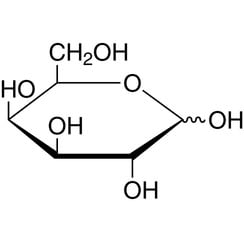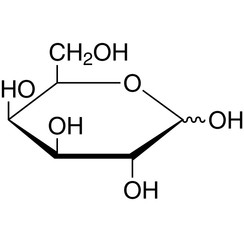You have no items in your shopping cart
Galactose
Galactose (/ɡəˈlæktoʊs/, galacto- + -ose, "milk sugar") sometimes abbreviated Gal, is a monosaccharide sugar that is about as sweet as glucose, and about 65% as sweet as sucrose. It is a C-4 epimer of glucose. A galactose molecule linked with a glucose molecule forms a lactose molecule.
Galactan is a polymeric form of galactose found in hemicellulose, and forming the core of the galactans, a class of natural polymeric carbohydrates.
Galactose is a monosaccharide. When combined with glucose (monosaccharide), through a condensation reaction, the result is the disaccharide lactose. The hydrolysis of lactose to glucose and galactose is catalyzed by the enzymes lactase and β-galactosidase. The latter is produced by the lac operon in Escherichia coli.
In nature, lactose is found primarily in milk and milk products. Consequently, various food products made with dairy-derived ingredients can contain lactose. Galactose metabolism, which converts galactose into glucose, is carried out by the three principal enzymes in a mechanism known as the Leloir pathway. The enzymes are listed in the order of the metabolic pathway: galactokinase (GALK), galactose-1-phosphate uridyltransferase (GALT), and UDP-galactose-4’-epimerase (GALE).
In human lactation, glucose is changed into galactose via hexoneogenesis to enable the mammary glands to secrete lactose. However, most lactose in breast milk is synthesized from galactose taken up from the blood, and only 35±6% is made from galactose from de novo synthesis. Glycerol also contributes some to the mammary galactose production.


